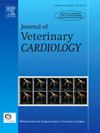马房室传导阻滞的心室相反应
IF 1.3
2区 农林科学
Q2 VETERINARY SCIENCES
引用次数: 0
摘要
房室结阻滞(AVN)的心室相反应(VR)的特征是当两个P波之间插入QRS复合体时,窦房周期长度缩短。这在人类和患有AVN阻滞的狗身上有很好的记录,但在马身上没有。本文中,我们描述了一匹具有二级AVN阻滞和恒定PR间隔的马,其在休息时表现出5:3的传导和疑似VR,但在次大运动后不那么一致。提出的VR机制包括:(1)心室收缩时收缩末期体积减少抑制Bezold-Jarisch反射;(2)心房内压力升高引起的迷走神经抑制(Bainbridge反射);(3)心室收缩时窦结血供的改变加速了窦结放电。本病例表现出前两种机制的一些心电图特征来解释PP间期改变和疑似VR。马经常表现出生理性AVN阻滞,临床医生在解释马的心电图时应该考虑VR。本文章由计算机程序翻译,如有差异,请以英文原文为准。
Ventriculophasic response in a horse with atrioventricular block
Ventriculophasic response (VR) in atrioventricular nodal (AVN) block is characterized by a shortening of the sinoatrial cycle length when a QRS complex is interposed between two P waves. This has been well documented in humans and dogs with AVN blocks but not in horses. Herein, we describe a horse with second-degree AVN blocks and constant PR intervals that exhibited 5:3 conduction and suspected VR at rest but less consistently after submaximal exercise. Proposed VR mechanisms include (1) inhibition of the Bezold-Jarisch reflex from reduced end-systolic volume during ventricular contraction; (2) vagal inhibition from increased intra-atrial pressure (Bainbridge reflex); and (3) accelerated sinus node discharge from changes in sinus nodal blood supply during ventricular contraction. This case exhibited some electrocardiogram characteristics of the first two mechanisms to explain the PP interval alteration and suspected VR. Horses often exhibit physiologic AVN blocks, and clinicians should consider VR when interpreting equine electrocardiograms.
求助全文
通过发布文献求助,成功后即可免费获取论文全文。
去求助
来源期刊

Journal of Veterinary Cardiology
VETERINARY SCIENCES-
CiteScore
2.50
自引率
25.00%
发文量
66
审稿时长
154 days
期刊介绍:
The mission of the Journal of Veterinary Cardiology is to publish peer-reviewed reports of the highest quality that promote greater understanding of cardiovascular disease, and enhance the health and well being of animals and humans. The Journal of Veterinary Cardiology publishes original contributions involving research and clinical practice that include prospective and retrospective studies, clinical trials, epidemiology, observational studies, and advances in applied and basic research.
The Journal invites submission of original manuscripts. Specific content areas of interest include heart failure, arrhythmias, congenital heart disease, cardiovascular medicine, surgery, hypertension, health outcomes research, diagnostic imaging, interventional techniques, genetics, molecular cardiology, and cardiovascular pathology, pharmacology, and toxicology.
 求助内容:
求助内容: 应助结果提醒方式:
应助结果提醒方式:


